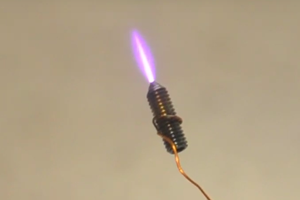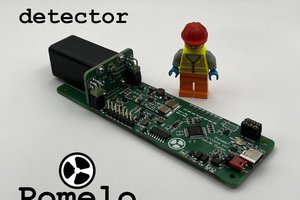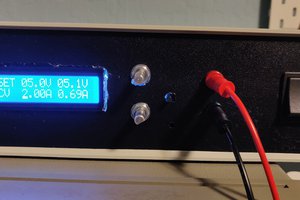DIY Scintillation Detector
Not your granddad's Geiger Counter
Not your granddad's Geiger Counter
To make the experience fit your profile, pick a username and tell us what interests you.
We found and based on your interests.
PMT Socket.pdfSchematics for the Voltage Divider board.Adobe Portable Document Format - 77.32 kB - 08/29/2019 at 10:52 |
|
|
PMT Socket.zipUpdated PCB Gerbers for the PMT Divider board.Zip Archive - 13.70 kB - 08/29/2019 at 10:50 |
|
|
HVPSU_V2.zipUpdated PCB Gerbers for the HV supplyZip Archive - 33.13 kB - 08/29/2019 at 10:50 |
|
|
Detector Housing.STEP.STEP File for the 3 components of the housing. Print away. All parts fit together with an interference fit. Should be secured with some duct tapestep - 69.88 kB - 07/11/2019 at 06:40 |
|
|
HVPSU.pdfSchematic for the High Voltage Power Supply. Updated Versionapplication/pdf - 220.12 kB - 07/11/2019 at 06:34 |
|
|
Well, this is both the resolution for the project and the measurement of the energy resolution (pun intended?).
I've taken some rough measurements, just so as to see the general ballpark i'm in regarding energy resolution.
For 226 Radium from a "choob" (Tube) meant for Radars, i got about 9.4 % FWHM (Full Width at Half Maximum) which is pretty close to the 8% a regular Sodium Iodide crystal has. Granted, they're usually spec'd for 8% FWHM 662keV, but i've still got some noise in the cables and too much digital gain. Amplifier PCBs are here, but i'm still waiting for parts.
What i was expecting
There's a lot of background and XRF, but the peaks are where they should be and, with some copper shielding and a lead castle I'll get better results.
For now, I'm quite pleased with the result.
After waiting for the right LT1534-1 ICs to arrive, today I finally completed the HV supply.
I've powered them up and tested them. The gods were kind because everything worked perfectly from the first try.
The 2 boards, assembled and tested.
Thermal image. Hottest component under load is the Controller IC, clocking in at 40 Degrees Celsius.
Powering the detector with the brand new supply.
The 2 finished supplies.
Big Orandge Drop capacitors. I tried 2 different configurations of the output Pi RC filter. Both seemed to perform equally good.
Output noise measured in a 100MHz bandwith is around 1.5-2 mV. Didn't take a photo of the measurement setup because i was juggling 3 probes, decoupling caps and knobs.
So, the detector itself is completed. Untill i get the materials for a complete aluminium housing, I'll stick to using the 3D printed one i've already got.
The detector itself feels quite nice in the hand (it's pretty darn comfy, if I do say so myself) and nicely weighted and balanced. An aluminium housing would only improve the overall look and feel.
I've finally gotten all the parts from Digikey, including the Amphenol BNCs on the back.
One is for the negative high voltage and the other one is for the output signal.
It's a tight squeeze, but 2 BNC cables DO fit at the same time.
Sorry about the potato quality photo, but my phone's camera is really crap.
So i finished 3D printing the housing, my parts aren't here yet, but I cobbled together a High Voltage PSU and tested the detector. And it works just as expected: great :D
Just background radiation picked up by the crystal. It picks up somewhere around 30 events per second, my Geiger Counter picks one up every 5 seconds or so (A Gamma Scout w Alert). Goes to show how much more sensitive a scintilation counter is.
Didn't get the BNC's either, so i drilled a couple of holes in the back cap and ran the wires through.
And this is my workbench. The pink block is a Wima filter capacitor filtering the -1000V supply for the PMT
Took a few days, but i've finally finished the PCB design for all the components of the detector.
I know i'm posting everything in one day, but this took a loong while.
Schematic editing and picking parts took about 1 day, PCB layout took another one.
What is a scintillation counter? Why would anyone need one? What can it do?
A scintillation detector is a type of radiation detector that relies on a characteristic of various materials called Scintillation. This is the ability of a material to convert high energy photons (such as X-rays or Gamma rays) to lower energy photons (usually blue light) with a direct correlation between the number of photons emitted and the energy of the incident X-ray or Gamma ray. This relationship between incident energy and output "brightness" of a scintillation event is critical for Gamma Spectroscopy.
The light emitted by the scintilator is then picked up by a photomultiplier tube. PMT's are very interesting vacuum tubes and I can't possibly explain them in enough details here. In short, PMT's take in light and output a current proportional to the incident luminous flux.
See where we're going? Energy to light output -> Light output to current -> current over a resistor to a voltage -> profit?
That's the basics.
Most of the parts can be ordered off Digikey/Farnell/Mouser/RS.
Magnetics can be ordered as samples from Coilcraft, or bought from them directly.
PMT and crystal can be bought off eBay.
Boards can be ordered for cheap from PCBWay, JLCPCB or OSHPark.
I've designed this project so as to use as few esoteric parts as possible.
Easy enough... A bit of SMD soldering, a few THT components, a PMT socket and you're set. The PMT socket should be mounted on the other side of the voltage divider (round PCB)
You should measure the current draw of the supply (which should be <50mA under no load) and the voltage at the output (which you can adjust from ~600-1100V using the trimmer).
Make sure nothing is getting hot.
Create an account to leave a comment. Already have an account? Log In.
Working on a version of this myself, and I'm a bit inexperienced on how one would go about testing the power supply once the construction is completed. Any tips?
Thanks! On the schematic, you note "place only one resistor" at the feedback R2 and R5. Do you mean either R2 or R5 is an 820R resistor with the other left as an open circuit, and that it does not matter which one is used?
Exactly. Place either one. It doesn't really matter that much, but if you, for whatever reason, find that the primary drive oscillator doesn't start oscillating, you can switch the resistor to the other side.
Saw this project on Reddit, happy to see you brought it here. If I recall correctly, you said you got the tube for some preposterous price at a flea market, right?
Awhile ago I bought a Hamamatsu H7155 for a few bucks on eBay, planned on doing a teardown article for it, but perhaps I would be better off powering it up. According to the seller it was never used, still has a little Hamamatsu sticker over the aperture.
Yep, got it for about 50 cents. Guy who sold it pretended to be an electronics expert and he was bragging about the PMT being a "worthless dual triode". Didn't contradict him on the worthless part, why would I?
Become a member to follow this project and never miss any updates
By using our website and services, you expressly agree to the placement of our performance, functionality, and advertising cookies. Learn More

 Robert Hart
Robert Hart

 mihai.cuciuc
mihai.cuciuc
I hope someone can send me the complete circuit?